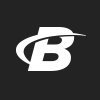Part 1 | Part 2
As soon as you mention big arms, the biceps are the first thing most people think of. While it's true that to have huge guns the triceps should not be ignored since they make up more arm size, you have to have fully developed biceps to really stretch the tape.
Most people love to train biceps, flexing their arms with pride at the end of every set, yet not always seeing the kind of results they want to see. This article will tell you how to get the results you want from your biceps training.
It's important to know the function of the muscle you're training in order to design a routine that properly works that muscle. The biceps is properly known as the biceps brachii and is a two headed muscle.
This muscle has two functions:
- Flexion—the action of bringing the arm up to the shoulder
- Supination—the action of twisting the wrist, or turning the thumbs away from the body
The brachialis is a small muscle which lies just beneath the biceps. It is not really a part of the bicep muscle but is included in the discussion because an untrained brachialis muscle can add up to an inch to your current arm size. How cool is that?
We're going to be using two routines because many bodybuilders stick to the same routine long after its stopped working. Research shows that 4-6 weeks is the most you want to spend on a routine, then it is time to change. Otherwise you hit a plateau and stop getting results.
You can use these two routines one of two ways—either do the first routine straight through for 4-6 weeks then go to Routine 2, or switch between the two each week (do Routine 1 for 1 week and Routine 2 for the next week).
Also, try to add weight to your exercises every week, even if it's just 2 1/2 lbs. Adding weight consistently is essential for growth.
The First Routine
Exercise 1. EZ-Bar Curl
2 working sets
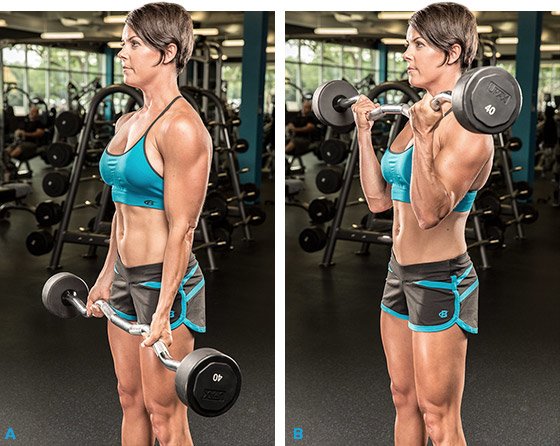
EZ-Bar Curl
These are done seated with your back braced to prevent cheating; you can also do this leaning against a wall. By doing them this way, your biceps do the work as opposed to your back and legs if your form is less than perfect.
This makes sense, why bother to do an exercise if it's not working the intended muscle? How do you expect to see results from exercises performed that way? Do it with your back and legs out of it and you'll feel the difference. The choice of bars: straight or EZ, is up to you. The EZ-bar is easier on the wrists and is also great for triceps work.
Exercise 2. Incline Dumbbell Curl
2 sets
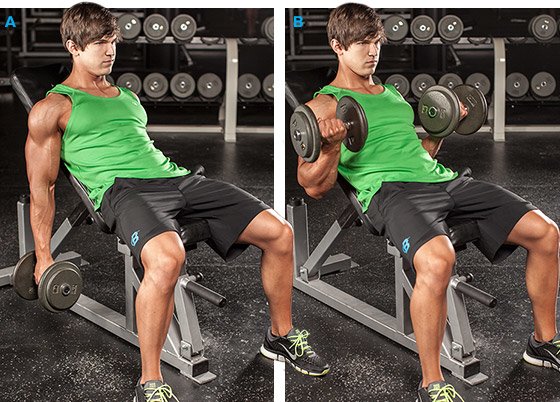
Incline Dumbbell Curl
To perform this exercise, start with your palms facing towards your legs when holding the dumbbells. As you curl up, twist the thumbs away from the body, as you lower; twist the thumbs back towards the body.
Exercise 3. Hammer Curls
2 sets
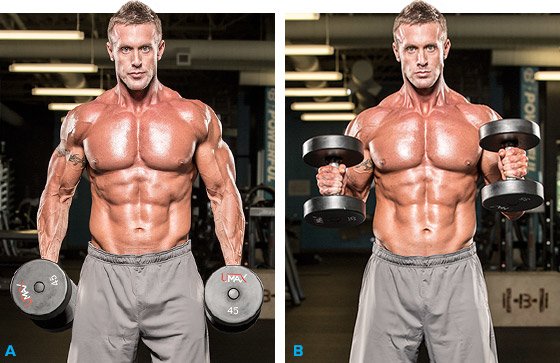
Hammer Curls
Do these by holding the dumbbell like a hammer, then curl up to the opposite shoulder.
Exercise 4. Standing Biceps Cable Curl
2 sets

Standing Biceps Cable Curl
Done seated or kneeling with arms across a flat bench- 2 sets. These will keep constant tension on the muscle from start to finish.
Do 6-8 reps to failure, extend the sets by using r/p, partials or forced reps. Always get 2 more, whether they are partials, forced, or whatever. Drop sets, which I love, may not work well here unless you have the resources for them. If so, by all means use those!
The Second Routine
Exercise 1. Alternate Incline Dumbbell Curls
2-3 sets of 6-8 reps
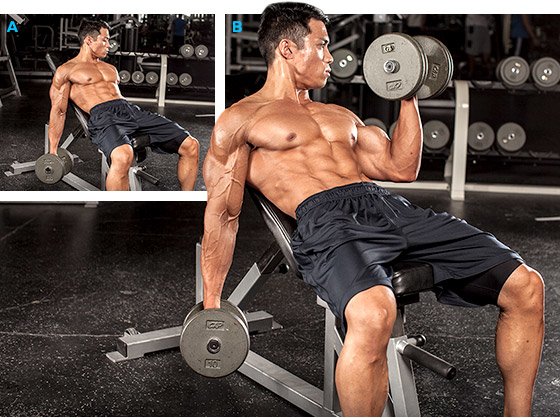
Alternate Incline Dumbbell Curls
Exercise 2. Barbell Curl
2 sets of 7 reps
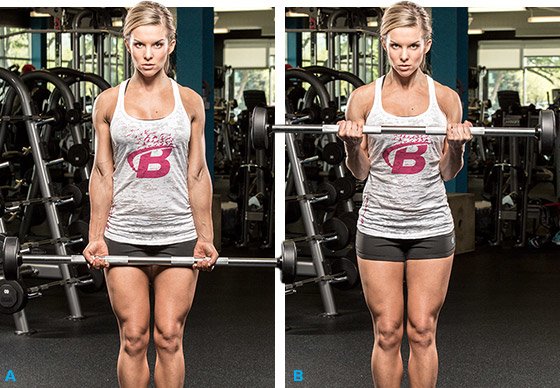
Barbell Curl
Do these with no momentum until the very end (2 or 3 controlled cheat reps are ok). These are done by doing the curl from the start position to halfway up, then back down for 7 reps, from halfway up to the top then back down to the halfway point for 7 reps and finally doing the complete curl for 7 reps. Don't wus out on the weight either, make it heavy so those last 7 take everything you've got!
Many bodybuilders that have problems with biceps development do so because they aren't using good form; they are attempting to do curls with a weight that is to heavy. So here you have someone, jerking the weight up with everything except the biceps and then failing to control it on the way down.
Why This Routine
What's the point of a rep like that? Yes, controlled cheating at the end of a set does have it's place but proper rep performance of any exercise for any muscle is extremely important. This means you have to be able to feel it in the target muscle, getting a good contraction every time.
Also, be sure to use a weight heavy enough to allow you to fail at the listed number of reps. Heavy weight, lifted correctly, builds muscle.
When performing bicep exercises, always keep your elbows in close to your sides, raise the weight slow enough to be able to feel it in your biceps, then lower the weight slowly (don't just drop it).
Rep tempo is also important - here I'm talking more about lowering the weight slowly. The thing to remember here is about tempo, it's not a race to see who can lift the fastest. Think 3-5 seconds up and the same down.
In most free weight curls, you lose the resistance at the top of the movement, most people flex hard at the top in an attempt to compensate for this. It might be better not to bring the weight up to that point but rather bring up to the point just before you lose the resistance, this will keep the muscle under more tension.
Don't lower to a dead stop either, keep the reps going, make it feel like one long rep, with constant tension the whole way through.
Everyone seems to work biceps after the back since the biceps are involved in all back exercises. It may make more sense to not train arms with the back because the back work directly hits biceps, fatiguing them before you actually start arm work. This means you can't hit your biceps as hard as you could if you trained them separately.
Train them away from back and you'll train with more intensity and more weight with better results.
